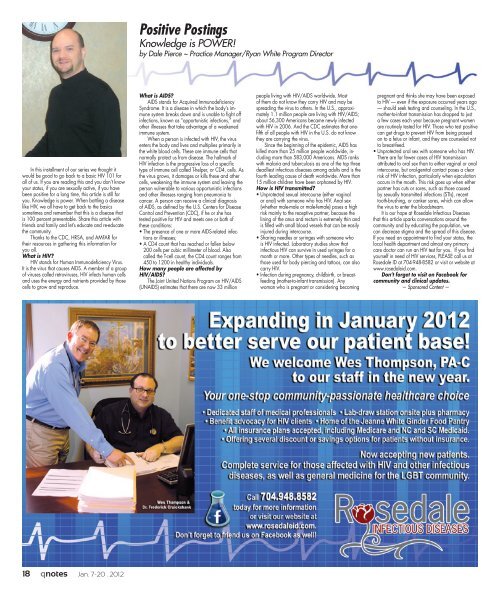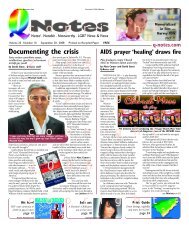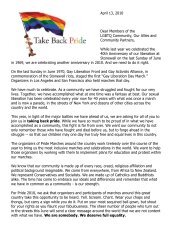Positive PostingsKnowledge is POWER!by Dale Pierce ~ Practice Manager/Ryan White Program DirectorIn this installment of our series we thought itwould be good to go back to a basic HIV 101 forall of us. If you are reading this and you don’t knowyour status, if you are sexually active, if you havebeen positive for a long time, this article is still foryou. Knowledge is power. When battling a diseaselike HIV, we all have to get back to the basicssometimes and remember that this is a disease thatis 100 percent preventable. Share this article withfriends and family and let’s educate and re-educatethe community.Thanks to the CDC, HRSA, and AMFAR fortheir resources in gathering this information foryou all.What is HIV?HIV stands for Human Immunodeficiency Virus.It is the virus that causes AIDS. A member of a groupof viruses called retroviruses, HIV infects human cellsand uses the energy and nutrients provided by thosecells to grow and reproduce.What is AIDS?AIDS stands for Acquired ImmunodeficiencySyndrome. It is a disease in which the body’s immunesystem breaks down and is unable to fight offinfections, known as “opportunistic infections,” andother illnesses that take advantage of a weakenedimmune system.When a person is infected with HIV, the virusenters the body and lives and multiplies primarily inthe white blood cells. These are immune cells thatnormally protect us from disease. The hallmark ofHIV infection is the progressive loss of a specifictype of immune cell called T-helper, or CD4, cells. Asthe virus grows, it damages or kills these and othercells, weakening the immune system and leaving theperson vulnerable to various opportunistic infectionsand other illnesses ranging from pneumonia tocancer. A person can receive a clinical diagnosisof AIDS, as defined by the U.S. Centers for DiseaseControl and Prevention (CDC), if he or she hastested positive for HIV and meets one or both ofthese conditions:• The presence of one or more AIDS-related infectionsor illnesses;• A CD4 count that has reached or fallen below<strong>20</strong>0 cells per cubic millimeter of blood. Alsocalled the T-cell count, the CD4 count ranges from450 to 1<strong>20</strong>0 in healthy individuals.How many people are affected byHIV/AIDS?The Joint United Nations Program on HIV/AIDS(UNAIDS) estimates that there are now 33 millionpeople living with HIV/AIDS worldwide. Mostof them do not know they carry HIV and may bespreading the virus to others. In the U.S., approximately1.1 million people are living with HIV/AIDS;about 56,300 Americans became newly infectedwith HIV in <strong>20</strong>06. And the CDC estimates that onefifthof all people with HIV in the U.S. do not knowthey are carrying the virus.Since the beginning of the epidemic, AIDS haskilled more than 25 million people worldwide, includingmore than 583,000 Americans. AIDS rankswith malaria and tuberculosis as one of the top threedeadliest infectious diseases among adults and is thefourth leading cause of death worldwide. More than15 million children have been orphaned by HIV.How is HIV transmitted?• Unprotected sexual intercourse (either vaginalor anal) with someone who has HIV. Anal sex(whether male-male or male-female) poses a highrisk mainly to the receptive partner, because thelining of the anus and rectum is extremely thin andis filled with small blood vessels that can be easilyinjured during intercourse.• Sharing needles or syringes with someone whois HIV infected. Laboratory studies show thatinfectious HIV can survive in used syringes for amonth or more. Other types of needles, such asthose used for body piercing and tattoos, can alsocarry HIV.• Infection during pregnancy, childbirth, or breastfeeding(mother-to-infant transmission). Anywoman who is pregnant or considering becomingpregnant and thinks she may have been exposedto HIV — even if the exposure occurred years ago— should seek testing and counseling. In the U.S.,mother-to-infant transmission has dropped to justa few cases each year because pregnant womenare routinely tested for HIV. Those who test positivecan get drugs to prevent HIV from being passedon to a fetus or infant, and they are counseled notto breast-feed.• Unprotected oral sex with someone who has HIV.There are far fewer cases of HIV transmissionattributed to oral sex than to either vaginal or analintercourse, but oral-genital contact poses a clearrisk of HIV infection, particularly when ejaculationoccurs in the mouth. This risk goes up when eitherpartner has cuts or sores, such as those causedby sexually transmitted infections (STIs), recenttooth-brushing, or canker sores, which can allowthe virus to enter the bloodstream.It is our hope at Rosedale Infectious Diseasesthat this article sparks conversations around thecommunity and by educating the population, wecan decrease stigma and the spread of this disease.If you need an appointment to find your status, thelocal health department and almost any primarycare doctor can run an HIV test for you. If you findyourself in need of HIV services, PLEASE call us atRosedale ID at 704-948-8582 or visit or website atwww.rosedaleid.com.Don’t forget to visit on Facebook forcommunity and clinical updates.— Sponsored Content —18 <strong>qnotes</strong> <strong>Jan</strong>. 7-<strong>20</strong> . <strong>20</strong>12
Q<strong>qnotes</strong> eventsgo<strong>qnotes</strong>.com/qguide/eventsarts. entertainment. news. views.<strong>Jan</strong>. 8 • Winston-SalemFirst Sunday Tea DanceWinston-Salem’s montly Sunday Tea Dancewill be held on a special New Year date on<strong>Jan</strong>. 8. No cover, free food, drink specials andmusic by DJ Clash. A percentage of the drinksales will benefit Equality Winston-Salem.Blue, 271 W. 4th St. 5-8 p.m. 336-918-0902.outatthemovieswinston.org.<strong>Jan</strong>. 11-15 • Chapel Hill‘No Child…’Nilaja Sun brings her exuberant, insightful,critically acclaimed portrait of life at fictionalMalcolm X High School to the PRC2 stage.“No Child…” has been showered withawards, including the Obie Award, OuterCritics Circle Awards for Best New AmericanPlay and Best Solo Performance and the USComedy Arts Festival Award for Best SoloShow. Elizabeth Price Kenan Theatre, Centerfor Dramatic Art, 150 Country Club Rd. Varioustimes. playmakersrep.org/nochild/.<strong>Jan</strong>. 14 • Winston-SalemFilm screeningOUT at the Movies Winston-Salem screens“Going Down in La-La Land” on the campusof the University of North Carolina School ofwe want yourwho/what/whereSubmitting an event for inclusion in ourcalendar has never been easier:visit go<strong>qnotes</strong>.com/qguide/events/submitthe Arts, 1533 S. Main St. 7-8:45 p.m. Ticketinformation call 336-918-0902.outatthemovieswinston.org.<strong>Jan</strong>. 14 • RaleighOpen mic nightExpress yourself on the second Saturday ofevery month as the LGBT Center of Raleighopens its doors to let you have your say atCenter OpenMic. We suggest the generaltopic of the month and hand you the microphone.Express yourself through dramaticreading, spoken word, scripted presentations,free expression. Coffee and refreshmentsprovided. Sign up to speak as you come in thedoor. LGBT Center of Raleigh, 411 HillsboroughSt. 7:30 p.m. Free. 919-832-4484.lgbtcenterofraleigh.com.<strong>Jan</strong>. 15 • Charlotte‘Queer As Folk’ DJ spinsFresh to the Charlotte scene, DJ Peter Prestaof “Queer As Folk” fame joins opening DJsJason Fotizo and Brittany Gaston with hostDan Mauney for a special “Queer As Folk”Circuit Party at Dharma Lounge, 1440 S. TryonSt. 704-334-8336. dharmacharlotte.com.<strong>Jan</strong>. 15 • Winston-SalemMr. Don’t H8Celebrity Jason Dottley of “Sordid Lives” willappear at the first national Don’t H8 pageant.Featuring Mr. Don’t H8 <strong>20</strong>11 Stone Parqueand Mr. Don’t H8 <strong>20</strong>10 Chip Matthews. ClubCO2, 4019 Country Club Rd. 9 p.m. facebook.com/event.php?eid=<strong>20</strong>3536659715229.<strong>Jan</strong>. 17 • CharlotteMeet the DunnsThe Charlotte Business Guild hosts a specialmonthly meeting with local transgenderactivist and civic leader Roberta Dunn andher wife, Jay. LGBT Community Center ofCharlotte, 8<strong>20</strong> Hamilton St., Suite B11. 5:30-8p.m. $<strong>20</strong> admission includes dinner. Cashbar available. charlottebusinessguild.org.gaycharlotte.com.<strong>Jan</strong>. 19 • CharlotteMiss Gay South CarolinaThe Miss Gay South Carolina U.S.ofA.Pageant, themed “Year of the Drag-On,” willbe held at Scorpio, 2301 Freedom Dr. 6 p.m.704-517-4009. info@scusofa.com.scusofa.com.<strong>Jan</strong>. 19-22 • Blowing RockGay Ski WeekendThe 4th Annual NC Gay Ski Weekend takesover Blowing Rock. Organizers say the eventwill be bigger and better than ever with morehost properties and more events, includingappearances by Logo’s “A List New York”star Rodiney Santiago and comedian FortuneFeimster from “Chelsea Lately.”ncgayskiweekend.com.<strong>Jan</strong>. <strong>20</strong>-Feb. 5 • Charlotte‘Doubt’Theatre Charlotte presents <strong>20</strong>05 PulitzerPrize and Tony Award winning play “Doubt:A Parable” by John Patrick Shanley. In theplay, Sister Aloysius, a Bronx school principal,suspects that the young Father Flynn has hadan inappropriate relationship with a malestudent. Theatre Charlotte, 501 Queens Rd.Days/times vary. Prices vary. 704-376-3777.theatrecharlotte.org.<strong>Jan</strong>. 21 • SalisburyBrent ChildersBrent Childers, executive director of Faith inA&EDharmaLoungepresents QAFcircuit partyAmerica, will speak at a regular meeting ofthe Salisbury-Rowan PFLAG. Haven LutheranChurch, <strong>20</strong>7 W. Harrison St. 10 a.m.-noon.Free. salisbury-pflag.org.<strong>Jan</strong>. 27-March 24 • CharlotteExhibit: CONVERGE“Converge” features renowned artistsQuisqueya Henriquez and Sonya Clark andthe pieces they created while in residenceat the Center. Exploring themes of identityand inclusion, the work showcased in theexhibition will represent a convergence ofart, history and diverse cultures. McCollCenter for Visual Art, 721 N. Tryon St. Hoursvary by day. 704-332-5535.mccollcenter.org.Feb. 5-7 • CharlotteCommunity HIV trainingThe Communicable Disease Branch ofthe N.C. Division of Public Health andother community partners present thefirst MAI/MSM Community and ProviderTraining Conference, bringing togetherrepresentatives from HIV care, treatmentand providers, along with members of thecommunity that are affected by HIV disease.Registration is free but required and coversall training conference meals. Seating andattendance is limited. Charlotte City CenterMarriott, 100 W. Trade St. Register online atnorthwestahec.wfubmc.edu/mura/www/#/event/36019.Charlotte’s Dharma Lounge will welcome with stylenationally renowned DJ and recent Charlotte newcomerDJ Peter Presta of “Queer As Folk” fame at their <strong>Jan</strong>. 15“Queer As Folk” Circuit Dance Party featuring host DanMauney of Takeover Friday and DJs Jason Fotizo andBrittany Gaston.Presta became well-known for his anthem “Proud,”the theme song for the hit Showtime series “Queer AsFolk.” The song will also be featured as the <strong>20</strong>12 LondonOlympics theme song. Peter has produced over 400 recordsand worked with artists like Duran Duran, Rihanna,Sade and Usher.Doors open for the <strong>Jan</strong>. 15 special event at 9 p.m. to those 18 and up. Cover is $10. DharmaLounge is located at 1440 S. Tryon St., Suite 105. For more information, visit dharmacharlotte.comor call 704-334-8336.Meetings: Third Tuesday of every month, except whenthere is specialized programming, plus monthly socials topromote networking and friendshipProgram: A wide variety of topics of interest to appeal to thediverse LGBT communityTime: After work with a cash bar social and heavy hor d’oeuvreswith dinner and program followingMembership: Visit the website for application options and benefits.Information: Call 704.565.5075or email businessguild@yahoo.comfor more details or write toThe Charlotte Business GuildP.O. Box 33371 | Charlotte, NC 28233www.charlottebusinessguild.org<strong>Jan</strong>. 7-<strong>20</strong> . <strong>20</strong>12 <strong>qnotes</strong> 19













